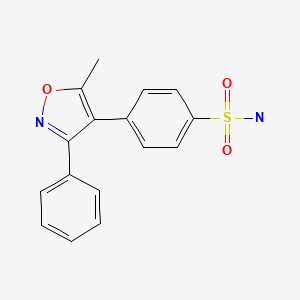Attribution Statement: LactMed is a registered trademark of the U.S. Department of Health and Human Services.
NCBI Bookshelf. A service of the National Library of Medicine, National Institutes of Health.
Drugs and Lactation Database (LactMed®) [Internet]. Bethesda (MD): National Institute of Child Health and Human Development; 2006-.
CASRN: 181695-72-7

Drug Levels and Effects
Summary of Use during Lactation
Valdecoxib was removed from sale in the United States by the U.S. Food and Drug Administration because of long-term cardiovascular toxicity. Limited information indicates that levels of valdecoxib in breastmilk are low. Because there is little published experience with valdecoxib safety during breastfeeding, other agents may be preferred, especially while nursing a newborn or preterm infant.
Drug Levels
Maternal Levels. A review article states that breastmilk levels of valdecoxib are much less than 200 mcg/L based on unpublished studies from the author's laboratory.[1]
Valdecoxib is the active metabolite that is rapidly formed from parecoxib. A single 40 mg dose of parecoxib was given intravenously to 40 mothers at an average of 41.9 hours after delivery. Four milk samples were collected over the next 24 hours. The average infant dosages in breastmilk were 0.24 mcg/kg daily for parecoxib and 1.82 mcg/kg daily for valdecoxib. This was equivalent to 0.63% of the weight-adjusted maternal dose in parecoxib equivalents, mostly excreted as valdecoxib. The half-life of valdecoxib in breastmilk was 8.5 hours.[2]
Infant Levels. Relevant published information was not found as of the revision date.
Effects in Breastfed Infants
A single 40 mg dose of parecoxib, a prodrug of valdecoxib, was given intravenously to 40 mothers at an average of 41.9 hours after delivery. The neonatal adaptive score of the breastfed infants was normal at an average of 21.8 hours after the dose.[2]
Effects on Lactation and Breastmilk
A study compared valdecoxib 20 mg and placebo twice daily for their opiate-sparing activity in post-cesarean section pain. All patients received epidural fentanyl and bupivacaine as well as intraspinal morphine for postoperative pain. No difference was observed in breastfeeding success rate between mothers who received valdecoxib (n = 25) and placebo (n = 23).[3]
Alternate Drugs to Consider
Acetaminophen, Flurbiprofen, Ibuprofen, Indomethacin, Naproxen, Piroxicam
References
- 1.
- Hale TW. Medications in breastfeeding mothers of preterm infants. Pediatr Ann. 2003;32:337–47. [PubMed: 12774709]
- 2.
- Paech MJ, Salman S, Ilett KF, et al. Transfer of parecoxib and its primary active metabolite valdecoxib via transitional breastmilk following intravenous parecoxib use after cesarean delivery: A comparison of naive pooled data analysis and nonlinear mixed-effects modeling. Anesth Analg. 2012;114:837–44. [PubMed: 22344242]
- 3.
- Carvalho B, Chu L, Fuller A, et al. Valdecoxib for postoperative pain management after cesarean delivery: A randomized, double-blind, placebo-controlled study. Anesth Analg. 2006;103:664–70. [PubMed: 16931678]
Substance Identification
Substance Name
Valdecoxib
CAS Registry Number
181695-72-7
Disclaimer: Information presented in this database is not meant as a substitute for professional judgment. You should consult your healthcare provider for breastfeeding advice related to your particular situation. The U.S. government does not warrant or assume any liability or responsibility for the accuracy or completeness of the information on this Site.
- User and Medical Advice Disclaimer
- Drugs and Lactation Database (LactMed) - Record Format
- LactMed - Database Creation and Peer Review Process
- Fact Sheet. Drugs and Lactation Database (LactMed)
- Drugs and Lactation Database (LactMed) - Glossary
- LactMed Selected References
- Drugs and Lactation Database (LactMed) - About Dietary Supplements
- Breastfeeding Links
- PubChem SubstanceRelated PubChem Substances
- PubMedLinks to PubMed
- Review Linezolid.[Drugs and Lactation Database (...]Review Linezolid.. Drugs and Lactation Database (LactMed®). 2006
- Review Sulfamethoxazole.[Drugs and Lactation Database (...]Review Sulfamethoxazole.. Drugs and Lactation Database (LactMed®). 2006
- Review Tolmetin.[Drugs and Lactation Database (...]Review Tolmetin.. Drugs and Lactation Database (LactMed®). 2006
- Review Pioglitazone.[Drugs and Lactation Database (...]Review Pioglitazone.. Drugs and Lactation Database (LactMed®). 2006
- Review Leflunomide.[Drugs and Lactation Database (...]Review Leflunomide.. Drugs and Lactation Database (LactMed®). 2006
- Valdecoxib - Drugs and Lactation Database (LactMed®)Valdecoxib - Drugs and Lactation Database (LactMed®)
Your browsing activity is empty.
Activity recording is turned off.
See more...
